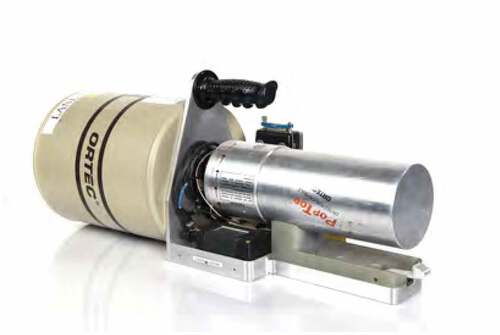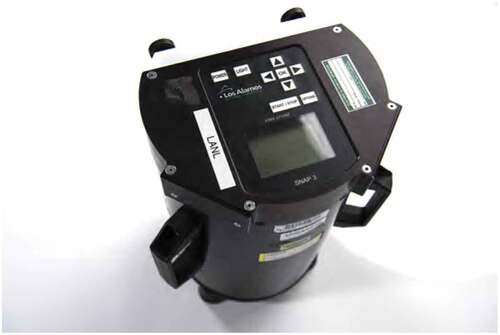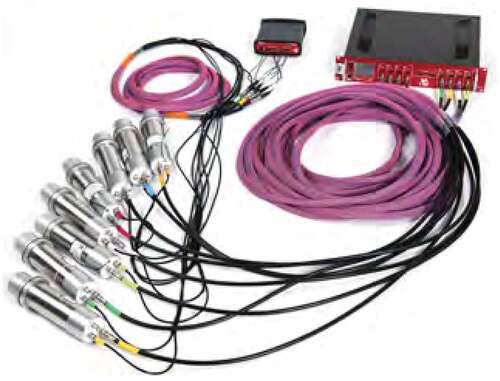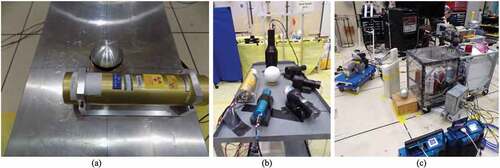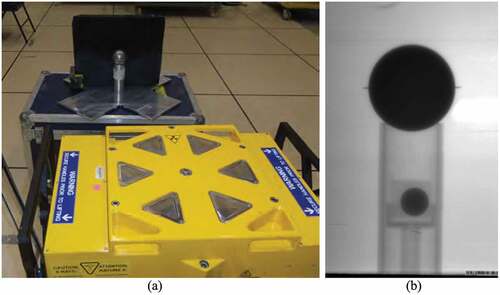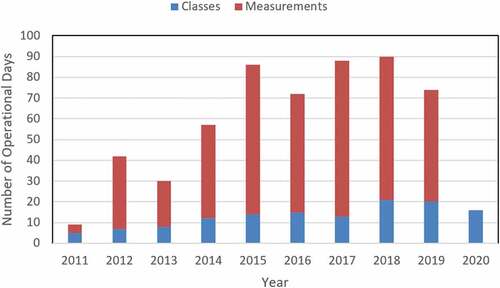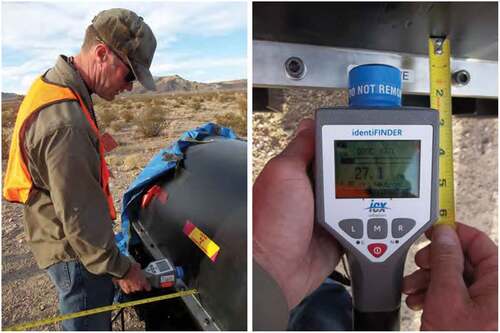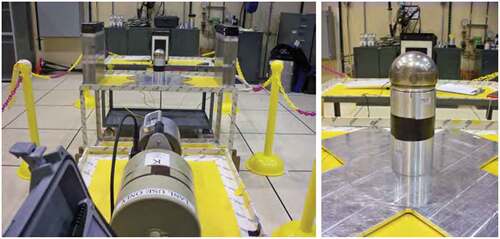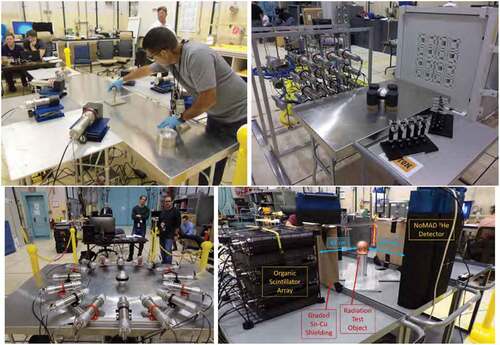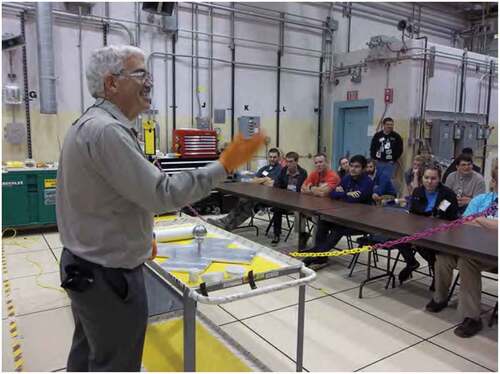 ?Mathematical formulae have been encoded as MathML and are displayed in this HTML version using MathJax in order to improve their display. Uncheck the box to turn MathJax off. This feature requires Javascript. Click on a formula to zoom.
?Mathematical formulae have been encoded as MathML and are displayed in this HTML version using MathJax in order to improve their display. Uncheck the box to turn MathJax off. This feature requires Javascript. Click on a formula to zoom.Abstract
The work presented in this paper focuses on the first 10 years (2011–2020) of radiation test object (RTO) operations at the National Criticality Experiments Research Center. RTOs are subcritical configurations of special nuclear material that are built by hand. These configurations are utilized for benchmark experiments, detector testing/characterization, and training. An overview of the types of measurements used in RTO operations is given as well as a history of RTO operations at Los Alamos National Laboratory from 1944–2011.
I. INTRODUCTION
Radiation test objects (RTOs), in the context of this work, are subcritical configurations of special nuclear material (SNM) that are built by hand. The configurations vary in SNM type, mass, form, and geometry, resulting in a wide range of subcritical neutron multiplication (from near 1 to about 20). These configurations often include moderator and/or reflector materials. RTOs have primarily been constructed for the purposes of training and radiation measurements and to provide information for the criticality safety community. RTOs are utilized for research and development (R&D) because their geometry, material characteristics, and radioactive emissions provide surrogates for real-world items of concern or interest.
This work will focus on RTO operations performed at the National Criticality Experiments Research CenterCitation1 (NCERC), which resides within the Device Assembly Facility (DAF) at the Nevada National Security Site. Prior to the startup of NCERC, Los Alamos performed RTO operations at the Los Alamos Critical Experiments Facility (LACEF) in Technical Area 18 (TA-18) from 1946–2006. Note that many names were used throughout the years to refer to the location (TA-18, Pajarito Site, and Pajarito University to name a few), but this work will refer to all of these operations during this time period as “LACEF.” In 2005, the U.S. Department of Energy (DOE) finalized the decision to move LACEF capabilities to Nevada. Efforts to upgrade and relocate the critical experiments capability to Nevada began. For relocation of the TA-18 nuclear material inventory, the pace quickened to characterize the inventory and to make disposition plans. RTO measurements began in the DAF in 2007 under Los Alamos National Laboratory’s Nuclear Material Handling and Measurement (NMHM) operations. shows the timeline of these capabilities from 1944 to the present.
TABLE I History of Los Alamos RTO Operations
This paper will start by describing operations conducted from 1944–2011 in Sec. II. Section III describes the types of measurements typically performed during RTO operations. Section IV focuses on the first 10 years of RTO operations at NCERC (2011–2020). The operations described include benchmark experiments (Sec. IV.A), detector testing and characterization (Sec. IV.B), university consortia measurements (Sec. IV.C), neutron diagnosed subcritical experiments (NDSEs) (Sec. IV.D), and training classes (Sec. IV.E). Last, conclusions and future work are discussed in Sec. V.
II. RTO HISTORY AT THE LOS ALAMOS CRITICAL EXPERIMENTS FACILITY
Understanding the critical mass of nuclear material was of great importance during the Manhattan Project. In order to address this, integral experiments were performed at Los Alamos. Of primary interest were critical mass data on highly enriched uranium (HEU) and weapons-grade plutonium (WG Pu). These early experimentsCitation2–4 were the first measurements ever performed on large (kilogram) quantities of HEU and plutonium metal and are similar to many of the RTO experiments discussed in this work. On August 21, 1945, shortly after the end of World War II, Harry Daghlian was conducting hands-on experiments with a 6.2-kg sphere of -phase WG Pu reflected by tungsten carbide bricks.Citation5 During the experiment, a brick slipped from his hand onto the assembly, resulting in a criticality accident that yielded a lethal dose of radiation to Daghlian. This resulted in moving these operations from Omega Canyon in Los Alamos to TA-18, a more remote area of the laboratory. A second criticality accident occurred on May 21 of the following year using the same plutonium core reflected by beryllium.Citation5 These two accidents led to a requirement that any systems that have a reasonable chance of reaching criticality must be controlled remotely,Citation6 ultimately leading to construction of several critical assembly machines and the establishment of LACEF (CitationRef. 7).
While many critical experiments occurred in the following years, hands-on measurements with subcritical systems were still performed at LACEF. These hands-on measurements are all labeled as RTO measurements for the purposes of this paper, although the term was not yet being used at the time. The RTO and critical assembly operations complement one another. Both utilize the same SNM, personnel, detection systems, and measurement methods. For this reason, some of the experiments presented in this work may look similar to, and share SNM with, experiments on the Planet,Citation8 Comet,Citation9 Flattop,Citation10 and Godiva IV (CitationRef. 11) critical assembly machines.
LACEF had a very large collection of unique SNM items, which included hundreds of kilograms of uranium and plutonium. All of this material was moved to NCERC and continues to be used to support the capability to create and measure RTOs. This work will focus on four particular SNM items made of one of the following elements: uranium, neptunium, and plutonium, which are among the “most popular” items due to the unique characteristics described below.
The Thor core consists of three pieces of -phase WG Pu that have a combined mass of approximately 9.5 kg (CitationRef. 12). The Thor core was originally used in a Comet experiment in which it was reflected with thorium,Citation9 hence the name. Combinations of Thor core pieces were measured in a well counter in the early 1980s to demonstrate what is now known as the Hansen-Dowdy formalism,Citation13 a neutron noise method that is still in use. The Thor core is extremely useful for RTO measurements because one can use combinations of the three pieces (along with 0.5-in.-diameter plutonium cylinders that can be inserted in the center piece) to achieve a wide range of plutonium masses (which will result in a large range of system multiplication). This same material has been used for measurements at NCERC as described in Sec. IV.B.
The Beryllium Reflected Plutonium (BeRP) ball (shown in ) was cast and clad in stainless steel in 1980. The BeRP ball consists of an -phase WG Pu sphere with a reported mass of 4483.884 g and density of 19.6039 g/cm
(CitationRef. 14). This SNM item was originally used in a Planet experiment in which it was reflected by beryllium,Citation15 hence the name. The majority of RTO operations with the BeRP ball since that time do not involve beryllium reflection. The BeRP ball is a very useful piece of SNM because it is a large mass of spherical plutonium but is still below the water-reflected critical mass for
-phase WG Pu (CitationRef. 16). The multiplication [total multiplication near 4.5 (CitationRef. 14)] and the neutron emission [near 1e6 n/s (CitationRef. 14)] of the BeRP ball are both fairly high, which is useful for detector testing and validation.
Fig. 1. (a) Photograph of the BeRP ball. (b) Schematic showing the BeRP ball cladding. (c) Setup of the nickel-reflected subcritical benchmark.Citation54

In addition to using the BeRP ball in several benchmark experiments at NCERC (described in Sec. IV.A), the BeRP ball was also used for many detector validation measurements at LACEF (CitationRef. 17). Objectives of these measurements included training, technology functionality, and algorithm validation and verification. Between 2007 and 2011, the BeRP ball was used for several measurements at the DAF under NMHM operations. These included experiments reflected with polyethylene (shown in ) (CitationRefs. 18, Citation19, and Citation20), Lucite,Citation18,Citation21 and nickel.Citation18,Citation22 These experiments had a variety of goals, but most focused on neutron noise measurements. Many simulations of the BeRP ball were also performed in this time frame,Citation23,Citation24 including simulations of specific experiments conducted at the DAF (CitationRef. 25). Furthermore, these measurements and simulations were used with sensitivity methods, often to help inform nuclear data, with a focus on Pu
(CitationRefs. 26 through 30). Experiments with the BeRP ball at NCERC are described in Secs. IV.A, IV.B, and IV.C.
Fig. 2. Experiment with the BeRP ball reflected by polyethylene, performed in 2009 at DAF (CitationRef. 19)
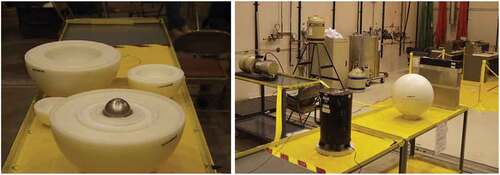
In the mid-1990s, the Rocky Flats (RF) metal uranium shells were relocated from the former Rocky Flats Critical Experiments Facility to Los Alamos for use at LACEF. The RF shells are nesting hemishells of HEU metal, each approximately 1/8 in. thick.Citation31,Citation32 There are 80 hemishells in total, resulting in well over a critical mass of bare HEU. The RF shells are useful for RTO operations due to the ability to create a large number of combinations of shells, allowing for varying mass and geometry. These hemishells have been used on Planet in experiments with the BeRP ballCitation33 and the Np sphere.Citation34 In the 1990s and early 2000s, many RTOs were assembled with the RF hemishells. Various configurations were assembled and measured with
He detection systems. These included passive measurements with no source as well as active measurements with driving sources of
Cf, (
,n), photoneutrons (using a Betatron), and 14-MeV neutrons (using a neutron generator).Citation35 These measurements supported active diagnostic technique development efforts. Many measurements included a Linitron 2000 (pulsed bremsstrahlung with 10-, 8-, and 6-MeV endpoint energies). Various neutron noise methods were analyzed using these RF measurements.Citation36–41 Simulations were then performed and compared to measured data.Citation42–44 Experiments with the RF hemishells at NCERC are described in Secs. IV.C and IV.D.
A sphere of Np was cast at Los Alamos in 2001 (CitationRef. 45) in order to investigate the critical mass of
Np. The
Np sphere has a mass of 6070.4 g and is surrounded by tungsten and nickel to reduce the gamma dose rate. Neptunium-237 has many unique properties, which makes this item useful for RTO operations. The critical mass experiment with the
Np sphere was performed on the Planet critical assembly machine in which it was surrounded by RF hemishells.Citation34,Citation46,Citation47 To support this experiment, subcritical multiplication measurements were performed in advance at LACEF to provide approach-to-critical information.Citation48 Experiments with the
Np sphere at NCERC are described in Sec. IV.A.
III. TYPES OF MEASUREMENTS
Many applications benefit from the use of SNM for R&D purposes. Examples include nonproliferation, treaty verification, safeguards, emergency response, and criticality safety. The reason that RTOs are so useful is that they can be utilized to build configurations of relevance to those applications. Measurements performed with RTOs are generally focused on radiation or physical characteristics of a configuration. This includes gamma emission, neutron emission, or physical characteristics determined through radiography. Both passive and active measurements are performed on RTO configurations. Detection systems include both commercial off-the-shelf (COTS) systems and those developed by national laboratories and/or universities.
Gamma measurements can have multiple objectives. The most common objective is to investigate gamma spectra for radioactive nuclide identification using primary gamma rays and other features such as (n,) interactions. These spectra can also be used for detector characterization. Other output from radioisotope identification devices (RIIDs) and gamma imagers such as isotope identification and spatial information can be used to evaluate onboard identification and localization algorithms. Gamma detection systems of many types are used for RTO operations including organic scintillators (OSs), inorganic scintillators (ISs), and semiconductors. Last, gamma dose rates are often measured using standard health physics instrumentation. Gamma measurements are also performed for material control and accountability purposes (to help quantify the nuclear material). One example of a gamma detection system used for gamma spectrum analysis is a liquid nitrogen-cooled COTS system shown in .
Neutron measurements also have multiple objectives. Systems are used to infer the total neutron emission or dose rate from a configuration. Neutron noise analysis methods are also used, which take advantage of the fact that multiple neutrons can be created from a single fission event at the same time.Citation49,Citation50 Neutron noise methods are performed to infer the system multiplication and/or effective multiplication factor . Neutron imaging is an objective for some measurements. Neutron detector systems generally include proportional counters or scintillators. One system that estimates the neutron emission rate is the Shielded Neutron Assay Probe (SNAP) detector shown in . One example of a
He system that is often used for neutron noise measurements is the MC-15 detector (sometimes referred to as the NoMAD detector),Citation14 shown in . An example of an OS system used for neutron noise measurements is shown in .
Both passive and active neutron measurements can provide useful information on measured configurations. Active interrogation (AI) is often performed with a deuterium-tritium (D-T) or deuterium-deuterium neutron generator. In addition, photon sources may be used as well and provide neutrons through (,n) interactions. Active interrogation can provide additional information since the time of the introduction of the interrogating source particles can be utilized. This provides benefits for neutron multiplicity, imaging, and estimation of material isotopics. Active interrogation can be paired with any of the same detector types used in passive measurements. Examples of AI measurements at NCERC are shown in .
Radiography is an active measurement that typically uses X-ray generators. These devices usually use an electrical current to generate electrons and subsequently X-rays through bremsstrahlung. A detection system (which could be film or digital panels) is placed in line with the beam angle of the X-ray generator. Typically, an object (such as an RTO configuration) is located in between the X-ray generator and the detection medium. Through selection of energy and duration, varying amounts of X-ray penetration will occur through the object resulting in varying exposure to the detection system. For RTO operations, it is typical to perform both low-energy exposures (hundreds of kilo-electron-volts) and high-energy exposures (mega-electron-volts). An example of radiography at NCERC is shown in .
IV. RTO OPERATIONS AT NCERC
At NCERC, four components are required for successful RTO operations:
SNM: Hundreds of kilograms of plutonium and HEU are present at NCERC. Our team thinks of innovative ways to utilize existing material for new RTOs while also securing additional SNM from throughout the DOE complex.
Nonfissile inventory: From both historical and recent projects, NCERC has a large collection of nonfissile materials. These are largely reflector and/or moderator materials. This inventory includes various materials such as metals including depleted uranium (DU), beryllium, tungsten, nickel, copper, steel, and aluminum in addition to plastics such as high-density polyethylene (HDPE) and Lucite. While the geometries vary depending on application, we have a large collection of hemishells, as shown in , the majority of which nest with one another. This collection has continued to grow throughout the 2011–2020 time period focused on in this work.
Diagnostic systems: Our team has COTS and laboratory-developed neutron detectors (examples in ), gamma detectors (example in ), radiography equipment (example in ), sources, and neutron generators (example in ). Other organizations also bring in their own equipment, which could range from early prototypes to COTS systems.
Expertise: Our team includes experts in neutron detection, gamma detection, radiography, and criticality safety. This helps ensure not only that the RTO configurations can be safely assembled but also that participating organizations obtain quality data.
shows the number of operational days in which RTOs were built and measured at NCERC for each year, starting in August 2011. It should be noted that 2011 was not a full year of operations and therefore had fewer builds than subsequent years. COVID-19 greatly impacted our program in 2020, which ultimately resulted in fewer operations than in previous years. As seen in , RTO operations can be classified as either measurements or classes. On average, 23% of operational days during these 10 years were in support of classes while 77% were for measurements. In total, over 900 RTO configurations have been assembled in the first 10 years at NCERC.
Fig. 11. The SCRP experiment. (a) Partial assembly. (b) Assembled configuration with NoMAD detectors
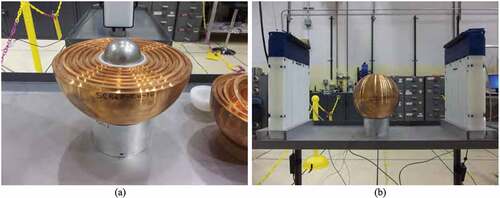
Fig. 12. The NeSO experiment. (a) Partial assembly. (b) Assembled configuration with NoMAD detectors

Fig. 14. Photograph and hot spot identification of COTS gamma imaging systems: (a) BeRP ball and (b) DU hemishells
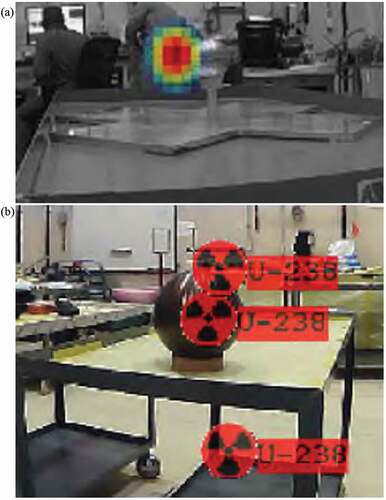
Fig. 15. Example of small plutonium samples that were placed in the Thor center piece for neutron multiplicity measurements
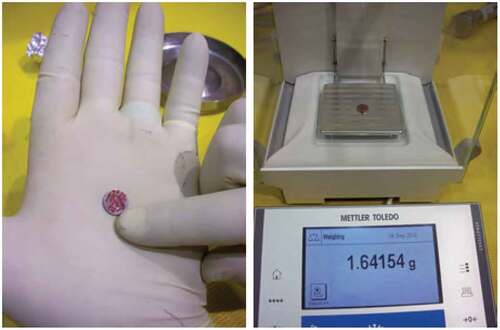
Fig. 18. (a) A subset of RF HEU hemishells. (b) Individual RF hemishells can be replaced with aluminum hemishells. (c) Rocky Flats hemishells 3–30 have a mass of 21.8 kg with dimensions shown
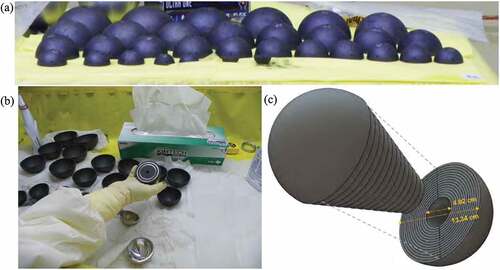
RTO operations can be further broken down into five types, which will be discussed in the following sections: benchmark experiments (Sec. IV.A), detector characterization (Sec. IV.B), university consortia measurements (Sec. IV.C), NDSEs (Sec. IV.D), and classes (Sec. IV.E).
IV.A. Benchmark Experiments
Subcritical benchmark measurements (sponsored by the Nuclear Criticality Safety Program) provide experimental data for nuclear data and computational method validation. These benchmarks are part of the International Criticality Safety Benchmark Evaluation ProjectCitation51 (ICSBEP) and include evaluation of all statistical and systematic uncertainties. In order to minimize uncertainties and make the configurations easier to model, simple geometries with few well-characterized materials are preferred. This is why the reflector materials shown in are spherical and composed of pure materials with few impurities. The Los Alamos RTO benchmarks are shown in .
TABLE II Los Alamos RTO Benchmarks
The first benchmark listed in was performed at LACEF, prior to the move to NCERC. This was a subcritical, source-driven, noise-analysis experiment, led by Oak Ridge National Laboratory in 2002 (CitationRef. 52). The detection system used in this experiment consisted of four 3He tubes inside an HDPE moderator. This source-driven experiment utilized a 252Cf source contained in a hemispherical ionization chamber. The RTO configurations included the BeRP ball with varying HDPE thicknesses of 0.00 to 7.62 cm. This experiment utilized the 252Cf Source-Driven Noise Analysis method,Citation52 a neutron noise technique that utilizes correlations between different detectors (cross-power spectral density) and the same detector (auto-power spectral density) to infer the system .
The BeRP/nickel (CitationRefs. 53 and Citation54) and BeRP/tungsten (CitationRefs. 55, Citation56, and Citation57) experiments were the first benchmark experiments performed at NCERC. For these experiments, seven and eight configurations were respectively performed with variable reflector thicknesses (both ranging from 0.00 to 7.62 cm). Both used the NPOD detection system,Citation54 which consists of 15 He tubes moderated with HDPE. The measured results were analyzed using the Hage-Cifarelli formalismCitation58 of the Feynman variance-to-meanCitation59 method. This is a neutron noise method in which the deviation of the measured data from a Poisson distribution within time gates is used to infer multiplicity. For these benchmarks, the values and uncertainties of three parameters were reported: the singles count rate
, which is the rate at which one neutron from a fission chain is detected; doubles count rate
, which is the rate at which two neutrons from a fission chain are detected; and leakage multiplication
. The setup for these experiments is shown in , where both the SNAP and high-purity germanium (HPGe) detectors were also used.
The Subcritical Copper-Reflected -phase Plutonium (SCR
P) experiment, shown in , was performed at NCERC in 2016 and published in ICSBEP in 2019 (CitationRefs. 14 and Citation60). This experiment included 17 configurations with the BeRP ball. The reflectors included various combinations of copper and HDPE ranging from 0.00 to 10.16 cm. These reflector combinations were chosen to obtain a large range of system multiplication values in addition to maximizing copper nuclear data sensitivities.Citation61 This experiment utilized the NoMAD detection system, which, like the older NPOD system, is also a multiplicity detector with 15
He tubes moderated with HDPE. The same benchmark parameters (
,
, and
) from the BeRP/nickel and tungsten experiments were evaluated for SCR
P. The French technical safety organization Institut de Radioprotection et de Surete Nucleaire (IRSN) and Lawrence Livermore National Laboratory both performed independent, external reviews for the SCR
P experiment.
The Neptunium Subcritical Observations (NeSO) experimentCitation62 was performed at NCERC in 2019. This experiment utilized the Np sphere, where eight configurations were measured including the bare sphere and varying nickel hemishells, with a maximum thickness of 9.14 cm. Nickel was chosen as the reflector since it led to the highest multiplication factor among several reflectors investigated including copper, tungsten, iron, beryllium, beryllium oxide (BeO), and molybdenum (CitationRef. 63). The only reflector material that outperformed nickel was tungsten carbide; however, the marginal improvements in performance were judged not to be worth the large cost difference. Note that
Np is a threshold fission nuclide; thus, the best reflectors for
Np are very different from those of fissile nuclides. The NeSO experiment has a much larger sensitivity to
Np fission than any experiments currently in the ICSBEP Handbook (including the Planet neptunium critical mass experiment utilizing the same
Np sphere). The NeSO experiments utilized the NoMAD detection system, similar to the SCR
P experiment, and the Detective X device (a mechanically cooled HPGe COTS system). During preliminary measurements prior to NeSO, it was determined that the neutron count rate was higher than anticipated from simulations but lower than given from measurements in the early 2000s. These results seemed to indicate that perhaps a nuclide with a high spontaneous fission rate was present in addition to the already known
Pu. Neutron and gamma data indicated that
Cm was the most likely nuclide, but additional work is being performed to confirm if this is the case and to ideally quantify the amount of
Cm present. The NeSO experiment is shown in .
Subcritical benchmark measurements enabled R&D related to the advancement of methods. Measurement methods that utilized these subcritical benchmark experiments include research into the binning of Feynman histograms,Citation64 a figure of merit associated with these histograms,Citation65 and fitting of neutron noise parameters.Citation66 Additional research was performed in the area of neutron noise measurement uncertainty,Citation67–69 reproducibility,Citation70 the application of Bayesian sampling,Citation71,Citation72 and the use of parameters that are independent of detector efficiency.Citation73–75
Benchmark experiments are also valuable for validation of simulation methods, largely focused on development of new capabilities within MCNP®.Footnotea Examples of this research include list-mode simulations,Citation76–80 evaluation of multiplicity capabilities associated with the CGMF (CitationRef. 81) and FREYA (CitationRef. 82) physics event generators,Citation83,Citation84 and use of a genetic algorithm to recommend nuclear data changes for prompt neutron multiplicity.Citation85
IV.B. Detector Testing and Characterization
While benchmark measurements focus on characterizing a system for nuclear data and computational method validation, RTO operations are also performed to test and characterize detector systems (both hardware and algorithms). This work is performed for a variety of sponsors and utilizes various detector systems. The majority of measurements use well-characterized nuclear material, such as the BeRP ball and RF hemishells, to ensure that there are known values for comparison. Often, however, RTO configurations are also chosen to challenge the detection systems in specific ways. Some detector testing involves blind tests in which the RTO contents are unknown to those performing data acquisition and analysis. Configurations may be constructed at NCERC and taken to other locations; shows an example of a handheld COTS detector measuring a configuration in the field. Often, newer equipment will be tested against current state-of-the-art COTS systems. New detection systems often have goals that include reduction in size, weight, and operational cost of the equipment while maintaining, or improving, the scientific fidelity and precision needed for assessment.
Testing of gamma spectrometers involves several performance metrics. These include technical metrics, such as detector resolution and available energy range, in addition to operational metrics, such as battery life, weight, etc. Gamma spectra are often used to estimate uranium and plutonium isotopics, where the accuracy and uncertainties of these estimates are determined and compared between systems. Shielded detection and RIID performances are also assessed. RIID identification performance is based not only on hardware but also on software. For isotope identifications, true positives, false positives, and false negatives are evaluated using various RTOs. Since many of the detection systems are designed for nonproliferation applications, it is important that they perform well on actual SNM, and NCERC RTO operations provide one of the few locations to conduct such tests with greater than significant quantities of material.
Testing of gamma imaging systems utilizes RTOs designed to challenge hot spot location [i.e., the location(s) of SNM within a specific configuration]. These systems use photopeak and Compton scattering analysis coupled with optical information to identify the hot spot location(s). An example of this can be seen in for two COTS imaging systems. Some imaging systems include spectroscopic and isotope identification capabilities. All types of gamma detection systems are utilized for detector testing and characterization. Examples include OS, IS [including sodium iodide (NaI), cesium iodide (CsI), lanthanum bromide (LaBr), bismuth germanium oxide (BGO)], and semiconductors [including HPGe, cadmium zinc tellurium (CZT), and others].
Neutron systems of all types have also been used for testing and characterization. These include proportional counters (such as He,
He, and BF
), OSs, and solid-state detectors (boron or lithium based). Objectives for testing neutron systems include accuracy and uncertainty of neutron emission, neutron multiplication, SNM mass, and neutron energy. The large quantity of SNM and nonnuclear components make NCERC an ideal location for testing of neutron systems. RTO configurations range from low neutron emission (tens of neutrons per second) to high neutron emission (
10
n/s) and from low multiplication (M
1) to high multiplication (M
10). Configurations can be built that bound those expected for most applications.
One example of neutron measurements for detector testing and characterization used the Thor core with the NPOD neutron multiplicity detectors in 2012 (CitationRefs. 86 and Citation87). As mentioned in Sec. II, the Thor core consists of three parts (referred to as the upper, center, and lower pieces), with a combined mass of approximately 9.5 kg. The center piece has a 0.5-in.-diameter hole in which samples can be inserted. Various pieces of plutonium were inserted into the core, such as those shown in . Use of these samples allowed for the measurement of 14 configurations (all consisting of bare plutonium), ranging from 200 g (using the samples only) to 9.8 kg (consisting of all three Thor core pieces and plutonium samples). The setup for this experiment is shown in . These experiments provided characterization data to show the limitations of the detection system; the minimum mass difference between configurations that could be distinguished depends upon the system multiplication and was previously documented.Citation86 Data from these measurements were used to test new features within MCNP including list-modeCitation87 and fixed-source sensitivityCitation88 capabilities.
IV.C. University Consortia Measurements
From 2015–2019, over 40 experiments were performed at NCERC for two Defense Nuclear Nonproliferation (DNN) university consortia. This included the Consortium for Nonproliferation Enabling Capabilities,Citation89 led by North Carolina State University (NCSU) and the Consortium for Verification TechnologyCitation90 led by the University of Michigan. These measurements were performed on RTOs, primarily consisting of configurations containing the BeRP ball, RF hemishells, or the Np sphere. Some experiments, shown in , also included AI. gives a summary of the consortia measurements. Over the 5-year duration, eight universities participated in these experiments: NCSU, the University of Michigan, the University of Illinois at Urbana-Champaign, Purdue University, Princeton University, North Carolina Agricultural and Technical State University, the University of Florida, and the Georgia Institute of Technology. In total, 15 faculty members and 41 students or postdocs participated in these experiments. Forty unique experiments were performed, and 110 configurations were measured. shows some of the measurements performed during these measurement campaigns.
TABLE III Summary of University Consortia Experiments
The experiments had varying goals and included different detection systems. NCSU investigated anisotropy in neutron-neutron coincidencesCitation91 (shown on the left of ) and spatial characteristics of SNM (CitationRef. 92) by performing measurements on the BeRP ball and RF hemishells with OS. The University of Michigan studied uranium isotopics of the RF hemishells using gamma spectroscopy with CZT detectorsCitation93,Citation94 and delayed neutron information from AI with lithium glass and PVT detectors.Citation95 The University of Michigan used OSs (CitationRef. 96), ISs (CitationRefs. 97 and Citation98) (shown in the top-right of ), and silicon photomultipliersCitation99 to study neutron and gamma imaging. NCSU and the University of Florida also performed imaging experiments using optically stimulated luminescence dosimetersCitation100 and a system that utilized OS and Lidar.Citation101 Princeton University performed measurements with NaI for template matching to provide information barriers within treaty verification.Citation102,Citation103 The University of Michigan performed Rossi- measurements with OS and
He detector systems (shown in the bottom-right of ) (CitationRefs. 104, Citation105, and Citation106).
IV.D. Neutron Diagnosed Subcritical Experiments
The NDSEs were designed to measure the fission chain decay of RTOs initiated by neutrons from an external source. NDSE measurements have been performed at NCERC since 2016. Three static objects have been constructed to date: Object 1 (shown ) consists of RF hemishells 3–30 (21.8 kg) (shown in ) reflected by 6.35-cm-thick HDPE. Object 2a (shown in ) uses RF hemishells 1–34 (29 kg) (shown in ) reflected by 2.00-cm-thick HDPE. Object 2b is identical to Object 2a except it does not contain any HDPE (CitationRef. 107). Objects 2a and 2b are above the water-reflected critical mass for HEU metalCitation16 and therefore require unique criticality safety requirements to assemble. Some configurations include the replacement of RF hemishells with aluminum hemishells (shown in ).
Fig. 19. (a) NDSE Object 1 measurements. (b) NDSE Object 1 being assembled for DPF operations. (c) NDSE Object 2a during construction

Measurements with these objects were performed with multiple neutron sources including Cf, AmBe, and a D-T neutron generator. Multiple detection systems have been employed for NDSE including OS, BGO IS, and
He systems. The scintillator systems are primarily used for gamma-ray die-off analysisCitation107 while the neutron detectors utilize neutron noise methods.Citation108,Citation109 As shown in , some measurements were performed outside the DAF. Here, Object 1 was assembled for measurements using a dense plasma focus (DPF) neutron source.
IV.E. Classes
As mentioned in Sec. IV, NCERC has a large inventory of SNM; a large collection of detection systems; and experts in neutron detection, gamma detection, and radiography. This makes NCERC a great place to conduct hands-on training. Students/attendees of NCERC classes include criticality safety practitioners, glove box operators, managers of fissionable material handlers, and personnel working in nonproliferation. A demonstration with the BeRP ball and Np sphere (shown in ) has been a part of the Nuclear Criticality Safety Program training for criticality safety practitioners and managers since the establishment of NCERC in 2011. Starting in 2017, NCERC has partnered with the DNN Nuclear Science and Security ConsortiumCitation110 (led by the University of California, Berkeley) to give workshops for the Keepin summer school.Citation111
Classes are tailored based upon the objectives and attendees. Most classes include a hands-on demonstration with the BeRP ball and Np sphere complemented with discussion of criticality safety, thermal properties of plutonium, neutron emission and multiplication (for plutonium, neptunium, and uranium systems), reflection, and neutron absorption. Some classes also include overviews of neutron and/or gamma detection and may include radiography. Demonstrations on the Planet,Citation8 Comet,Citation9 Flattop,Citation10 and/or Godiva IV (CitationRef. 11) critical assembly machines may also be performed.
V. CONCLUSIONS AND FUTURE WORK
Radiation test objects are uniquely useful because their geometry, material characteristics, and radioactive emissions provide surrogates for real-world items of concern or interest. This makes RTOs especially useful for detector testing and validation. The multiplication and neutron emission of RTOs also make them useful for benchmarks, which can be used to validate nuclear data and code capabilities. Highlights from the first 10 years of RTO operations at NCERC were presented. Over 900 RTO configurations were constructed in the first 10 years at NCERC, primarily for measurements involving neutron detection, gamma detection, and/or radiography. While RTO operations slowed in 2020 due to COVID-19, the future of these operations is bright and will include many measurements, experiments, and classes.
Acknowledgments
This work was supported by the DOE Nuclear Criticality Safety Program, funded and managed by the National Nuclear Security Administration for the DOE. Work detailed within this document was performed with the support of many sponsors including the Nuclear Criticality Safety Program, Nuclear Counter-Terrorism, Defense Threat Reduction Agency, DNN, and others.
This work was supported by the US Department of Energy through the Los Alamos National Laboratory. Los Alamos National Laboratory is operated by Triad National Security, LLC, for the National Nuclear Security Administration of the US Department of Energy under Contract No. 89233218CNA000001.
The authors would like to thank all involved in the success of these measurements (including all logistics to perform measurements in a nuclear facility). We would like to specifically thank the following individuals for their significant contributions to RTO operations in the past 10 years: Jennifer Alwin, Rian Bahran, Timothy Beller, Benoit Richard, Timothy Dugan, James Dyson, Jeffrey Favorite, Ryan Kamm, Keith Lash, Donnette Lewis, Alex Lynn, Justin Martin, John Mattingly, Mark Mitchell, Dane Spearing, Clell Solomon, Avneet Sood, Kenneth Valdez, Timothy White, and Mission Support and Test Services/National Security Technologies operations.
Notes
a MCNP® and Monte Carlo N-Particle® are registered trademarks owned by Triad National Security, LLC, manager and operator of Los Alamos National Laboratory. Any third party use of such registered marks should be properly attributed to Triad National Security, LLC, including the use of the designation as appropriate. For the purposes of visual clarity, the registered trademark symbol is assumed for all references to MCNP within the remainder of this paper.
References
- D. HAYES et al., “Integral Experiments at the US National Criticality Experiments Research Center (NCERC), ” Proc. 2nd Topl. Mtg. Advances in Nuclear Nonproliferation Technology and Policy Conf.: Bridging the Gaps in Nuclear Nonproliferation (ANTPC 2016), Santa Fe, New Mexico, September 25–30, 2016, American Nuclear Society (2016); https://www.scopus.com/inward/record.uri?eid=2-s2.0-85027830260&partnerID=40&md5=189f840a772ba6ce1a8d32427001bee4 (current as of Jan. 18, 2021).
- A. HANSON, R. SERBER, and J. WILLIAMS, “Multiplication of Large 25 Spheres,” LAMS-230, Los Alamos Scientific Laboratory (1945).
- H. ANDERSON, “Neutron Multiplication in Spheres of 25,” LA-402, Los Alamos Scientific Laboratory (1945).
- R. CARTER, J. HINTON, and L. KING, “Critical Mass Measurements for a 25 Sphere in Tu and WC Tampers,” LA-442, Los Alamos Scientific Laboratory (1945).
- T. McLAUGHLIN et al., “A Review of Criticality Accidents,” LA-13638, Los Alamos National Laboratory (2000).
- R. SCHREIBER, “Pajarito Safety Regulations,” LAMS-456, Los Alamos Scientific Laboratory (1947).
- D. LOAIZA and D. GEHMAN, “End of an Era for the Los Alamos Critical Experiments Facility: History of Critical Assemblies and Experiments (1946–2004),” Ann. Nucl. Energy, 33, 17, 1339 (2006); https://doi.org/10.1016/j.anucene.2006.09.009.
- R. SANCHEZ et al., “A New Era of Nuclear Criticality Experiments, The First 10 Years of Planet Operations at NCERC,” Nucl. Sci. Eng., 195, S1 (2021); https://doi.org/10.1080/00295639.2021.1951077.
- N. THOMPSON et al., “A New Era of Nuclear Criticality Experiments, The First 10 Years of Comet Operations at NCERC,” Nucl. Sci. Eng., 195, S17 (2021); https://doi.org/10.1080/00295639.2021.1947105.
- D. HAYES et al., “A New Era of Nuclear Criticality Experiments, The First 10 Years of Flattop Operations at NCERC,” Nucl. Sci. Eng., 195, S37 (2021); https://doi.org/10.1080/00295639.2021.1947104.
- J. GODA et al., “A New Era of Nuclear Criticality Experiments, The First 10 Years of Godiva IV Operations at NCERC,” Nucl. Sci. Eng., 195, S55 (2021); https://doi.org/10.1080/00295639.2021.1947103.
- G. E. HANSEN and H. C. PAXTON, “Thor, A Thorium-Reflected Plutonium-Metal Critical Assembly,” Nucl. Sci. Eng., 71, 3, 287 (1979); https://doi.org/10.13182/NSE79-A19065.
- A. ROBBA, E. DOWDY, and H. ATWATER, “Neutron Multiplication Measurements Using Moments of the Neutron Counting Distribution,” Nucl. Instrum. Meth. Phys. Res., 215, 3, 473 (1983); https://doi.org/10.1016/0167-5087(83)90481-7.
- T. CUTLER, J. ARTHUR, and J. HUTCHINSON, “Copper- and Polyethylene-Reflected Plutonium-Metal-Sphere Subcritical Measurements,” International Handbook of Evaluated Criticality Safety Benchmark Experiments, NEA/NSC/DOC(95)03/IX, FUND-NCERC-PU-HE3-MULT-003, NEA 7328, Organisation for Economic Co-operation and Development, Nuclear Energy Agency (2019); https://doi.org/10.1787/e2703cd5-en.
- J. HUTCHINSON et al., “Plutonium Sphere Reflected by Beryllium,” International Handbook of Evaluated Criticality Safety Benchmark Experiments, NEA7328, Organisation for Economic Co-operation and Development,Nuclear Energy Agency (2007); https://doi.org/10.1787/e2703cd5-en.
- H. PAXTON and N. PRUVOST, “Critical Dimensions of Systems Containing 235U, 239Pu, and 233U,” LA-10860-MS, Los Alamos National Laboratory (1986).
- S. SEITZ et al., “Radiation Detection Evaluation: RadAssessor Characterizes Integrated Findings,” Proc. IEEE Symp. Nuclear Science, Fajardo, Puerto Rico, October 23–29, 2005, Vol. 1, p. 288 (2005); https://doi.org/10.1109/NSSMIC.2005.1596255.
- J. HUTCHINSON, “Subcritical Measurements of a Plutonium Sphere with Various Reflectors,” Trans. Am. Nucl. Soc., 99, 371 (2008).
- J. MATTINGLY, “Polyethylene-Reflected Plutonium Metal Sphere: Subcritical Neutron and Gamma Measurements,” SAND2009-5804, Sandia National Laboratories (2009).
- J. LI and J. MATTINGLY, “SNAP-3 Response Function and Its Application,” Trans. Am. Nucl. Soc., 108, 491 (2013).
- J. HUTCHINSON and T. VALENTINE, “Subcritical Measurements of a Plutonium Sphere Reflected by Polyethylene and Acrylic,” Nucl. Sci. Eng., 161, 357 (2009); https://doi.org/10.13182/NSE161-357.
- J. HUTCHINSON and J. BESS, “Subcritical Noise Measurements with a Nickel-Reflected Plutonium Sphere,” Nucl. Sci. Eng., 163, 285 (2009); https://doi.org/10.13182/NSE163-285.
- E. SHORES and B. TEMPLE, “Metallic Plutonium Sphere Multiplication Calculations,” Proc. 15th Topl. Mtg. Radiation Protection and Shielding Division, Atlanta, Georgia, April 13–18, 2008, American Nuclear Society (2008).
- E. SHORES et al., “Neutron Transmission Calculations for Several Moderated Plutonium Systems,” Proc. 2010 Topl. Mtg. Radiation Protection and Shielding Division, Las Vegas, Nevada, April 2010, American Nuclear Society (2010).
- S. O’BRIEN, J. MATTINGLY, and D. ANISTRATOV, “Sensitivity Analysis of Neutron Multiplicity Counting Statistics Using First-Order Perturbation Theory and Application to a Subcritical Plutonium Metal Benchmark,” Nucl. Sci. Eng., 185, 3, 406 (2017); https://doi.org/10.1080/00295639.2016.1272988.
- R. EVANS, J. LI, and J. MATTINGLY, “Adjoint Sensitivity Analysis in a Large-Scale Subcritical Plutonium Benchmark,” Trans. Am. Nucl. Soc., 108, 487 (2013).
- R. T. EVANS, J. K. MATTINGLY, and D. G. CACUCI, “Sensitivity Analysis and Data Assimilation in a Subcritical Plutonium Metal Benchmark,” Nucl. Sci. Eng., 176, 3, 325 (2014); https://doi.org/10.13182/NSE13-24.
- A. CLARK and J. MATTINGLY, “Data Assimilation of Nuclear Cross Sections Applied to Neutron Multiplicity Counting Experiments,” Trans. Am. Nucl. Soc., 118, 775 (2018).
- D. G. CACUCI, R. FANG, and J. A. FAVORITE, “Comprehensive Second-Order Adjoint Sensitivity Analysis Methodology (2nd-ASAM) Applied to a Subcritical Experimental Reactor Physics Benchmark: I. Effects of Imprecisely Known Microscopic Total and Capture Cross Sections,” Energies, 12, 21, 4219 (2019); https://doi.org/10.3390/en12214219.
- A. CLARK, J. MATTINGLY, and J. FAVORITE, “Application of Neutron Multiplicity Counting Experiments to Optimal Cross-Section Adjustments,” Nucl. Sci. Eng., 194, 4, 308 (2020); https://doi.org/10.1080/00295639.2019.1698267.
- G. TUCK, “Enriched Uranium-Metal Measurements, No. 1,” RFP-907, The Dow Chemical Company, Rocky Flats (1967).
- R. ROTHE, “Extrapolated Experimental Critical Parameters of Unreflected and Steel-Reflected Massive Enriched Uranium Metal Spherical and Hemispherical Assemblies,” INEEL/EXT-97-01401, Idaho National Engineeringand Environmental Laboratory (1997).
- R. SANCHEZ and D. LOAIZA, “Plutonium Sphere Surrounded by Highly Enriched Uranium,” International Handbook of Evaluated Criticality Safety Benchmark Experiments, NEA 7328,Organisation for Economic Co-operation and Development, Nuclear Energy Agency (2005); https://doi.org/10.1787/e2703cd5-en.
- D. LOAIZA, R. BREWER, and R. SANCHEZ, “Neptunium-237 Sphere Surrounded by Hemi-Spherical Shells of Highly Enriched Uranium,” International Handbook of Evaluated Criticality Safety Benchmark Experiments, NEA/NSC/DOC/(95)03/I, Specifications, Organisation for Economic Co-operation and Development, Nuclear Energy Agency (2009).
- C. GOULDING et al., “Determining keff of Subcritical Uranium Systems Using Spontaneous Fission, (α,n), and Photoneutron Sources,” Proc. 6th Int. Conf. Nuclear Criticality Safety, Versailles, France, September 19–23, 1999.
- A. GOULDING, W. MYERS, and C. HOLLAS, “Subcritical Measurements of Uranium Shells,” Trans. Am. Nucl. Soc., 79, 180 (1998).
- G. ESTES and C. GOULDING, “Subcritical Multiplication Determination Studies,” Proc. 5th Int. Conf. Nuclear Criticality Safety, Albuquerque, New Mexico, September 17–22, 1995.
- C. MOSS, C. HOLLAS, and W. MYERS, “Active Interrogation of Highly Enriched Uranium,” Proc. 11th Int. Conf. Modern Trends in Activation Analysis, Guildford, United Kingdom, June 20–25, 2004.
- C. MOSS et al., “Neutron Detectors for Active Interrogation of Highly Enriched Uranium,” IEEE Trans. Nucl. Sci., 51, 4, 1677 (2004); https://doi.org/10.1109/TNS.2004.832992.
- W. MYERS et al., “Photon and Neutron Active Interrogation of Highly Enriched Uranium,” AIP Conf. Proc., 769, 1688 (2004).
- C. HOLLAS, C. GOULDING, and W. MYERS, “Determination of Neutron Multiplication of Subcritcal HEU Systems Using Delayed Neutrons,” Nucl. Instrum. Meth. Phys. Res. A, 543, 559 (2005); https://doi.org/10.1016/j.nima.2004.12.016.
- G. ESTES and R. BROCKHOFF, “MCNP Multiplication Analysis of Subcritical HEU Experiments,” Trans. Am. Nucl. Soc., 79, 182 (1998).
- G. ESTES et al., “Computational Analysis of HEU Subcritical Multiplication Experiments,” Proc. 6th Int. Conf. Nuclear Criticality Safety, Versailles, France, September 19–23, 1999.
- R. LITTLE, M. CHADWICK, and W. MYERS, “Detection of Highly Enriched Uranium Through Active Interrogation,” Proc. 11th Int. Conf. Nuclear Reaction Mechanisms, Varenna, Italy, June 12–16, 2006.
- D. YEAMANS et al., “Fabricating a Tungsten Shielded and Nickel Clad Neptunium Sphere,” LA-UR-01-3786, Los Alamos National Laboratory (2001).
- D. LOAIZA et al., “Results and Analysis of the Spherical 237Np Critical Experiment Surrounded by Highly Enriched Uranium Hemispherical Shells,” Nucl. Sci. Eng., 152, 1, 65 (2006); https://doi.org/10.13182/NSE06-A2564.
- R. SANCHEZ et al., “Criticality of a 237Np Sphere,” Nucl. Sci. Eng., 158, 1, 1 (2008); https://doi.org/10.13182/NSE08-A2734.
- W. MYERS, C. GOULDING, and C. HOLLAS, “Sub-Critical Measurements in Support of the Los Alamos Neptunium Critical Experiments,” Trans. Am. Nucl. Soc., 98, 197 (2008).
- R. UHRIG, Random Noise Techniques in Nuclear Reactor Systems, The Ronald Press Company (1970).
- J. HUTCHINSON et al., “Subcritical Multiplication Experiments & Simulations: Overview and Recent Advances,” Proc. Advances in Nuclear Nonproliferation Technology and Policy Conf., Santa Fe, New Mexico, September 25–30, 2016, American Nuclear Society (2016).
- International Handbook of Evaluated Criticality Safety Benchmark Experiments/Nuclear Energy Agency, Organisation for Economic Co-operation and Development, Nuclear Energy Agency; https://doi.org/10.1787/e2703cd5-en.
- T. VALENTINE, “Polyethylene-Reflected Plutonium Metal Sphere Subcritical Noise Measurements,” International Handbook of Evaluated Criticality Safety Benchmark Experiments, NEA/NSC/DOC/(95)03/I, SUB-PU-MET-FAST-001, Organisation for Economic Co-operation and Development, Nuclear Energy Agency.
- B. RICHARD et al., “Nickel-Reflected Plutonium Metal Sphere Subcritical Measurements,” Trans. Am. Nucl. Soc., 111, 879 (2014).
- B. RICHARD and J. HUTCHINSON, “Nickel Reflected Plutonium Metal Sphere Subcritical Measurements,” International Handbook of Evaluated Criticality Safety Benchmark Experiments, NEA 7328, Organisation for Economic Co-operation and Development, Nuclear Energy Agency (2016); https://doi.org/10.1787/e2703cd5-en.
- J. HUTCHINSON et al., “Tungsten-Reflected Subcritical Measurements,” Trans. Am. Nucl. Soc., 112, 460 (2015).
- J. HUTCHINSON et al., “Recent Nuclear Criticality Safety Program Technical Accomplishments: Subcritical Benchmark of the Berp Ball Reflected by Tungsten,” Trans. Am. Nucl. Soc., 115, 711 (2016).
- B. RICHARD and J. HUTCHINSON, “Tungsten-Reflected Plutonium-Metal-Sphere Subcritical Measurements,” International Handbook of Evaluated Criticality Safety Benchmark Experiments, NEA 7328, Organisation for Economic Co-operation and Development, Nuclear Energy Agency (2016); https://doi.org/10.1787/e2703cd5-en.
- D. CIFARELLI and W. HAGE, “Models for a Three-Parameter Analysis of Neutron Signal Correlation Measurements for Fissile Material Assay,” Nucl. Instrum. Meth. Phys. Res. A, 251, 3, 550 (1986); https://doi.org/10.1016/0168-9002(86)90651-0.
- R. FEYNMAN, F. D. HOFFMANN, and R. SERBER, “Dispersion of the Neutron Emission in U-235 Fission,” J. Nucl. Energy, 3, 1, 64 (1956); https://doi.org/10.1016/0891-3919(56)90042-0.
- J. HUTCHINSON et al., “Measurements on a Subcritical Copper-Reflected Aphase Plutonium (Scrap) Sphere,” Trans. Am. Nucl. Soc., 117, 832 (2017).
- R. BAHRAN and J. HUTCHINSON, “Subcritical Copper-Reflected α-Phase Plutonium (SCRαP) Integral Experiment Design,” Trans. Am. Nucl. Soc., 114, 527 (2016).
- A. McSPADEN et al., “Neptunium Sphere Subcritical Observation (NESO) Final Experiment Design Update,” Trans. Am. Nucl. Soc., 119, 781 (2018).
- R. BAHRAN, T. CUTLER, and J. HUTCHINSON, “Neptunium Subcritical Observation (NESO) Integral Benchmark Experiment Design,” Trans. Am. Nucl. Soc., 117, 853 (2017).
- T. CUTLER, M. NELSON, and J. HUTCHINSON, “Deciphering the Binning Method Uncertainty in Neutron Multiplicity Measurements,” Trans. Am. Nucl. Soc., 111, 846 (2014).
- J. ARTHUR et al., “Improved Figure of Merit for Feynman Histograms,” Trans. Am. Nucl. Soc., 117, 983 (2017).
- J. HUTCHINSON et al., “Prompt Neutron Decay Constant Fitting Using the Rossi-Alpha and Feynman Variance-to-Mean Methods,” Trans. Am. Nucl. Soc., 117, 986 (2017).
- J. HUTCHINSON et al., “Validation of Statistical Uncertainties in Subcritical Benchmark Measurements: Part II – Measured Data,” Ann. Nucl. Energy, 125, 342 (2019); https://doi.org/10.1016/j.anucene.2018.10.021.
- J. D. HUTCHINSON et al., “Estimation of Uncertainties for Subcritical Benchmark Measurements,” Proc. Int. Conf. Nuclear Criticality Safety, Charlotte, North Carolina, September 13–17, 2015, American Nuclear Society (2015).
- J. HUTCHINSON et al., “Comparison of Predicted and Measured Subcritical Benchmark Uncertainties as a Function of Counting Time,” Trans. Am. Nucl. Soc., 119, 809 (2018).
- J. HUTCHINSON et al., “Reproducibility of Subcritical Measurements: Five Years of Plutonium Sphere Data,” Trans. Am. Nucl. Soc., 107, 638 (2012).
- J. M. VERBEKE, “Neutron Multiplicity Counting: Credible Regions for Reconstruction Parameters,” Nucl. Sci. Eng., 182, 4, 481 (2016); https://doi.org/10.13182/NSE15-35.
- S. WALSTON et al., “Analysis of Fast Neutron Data from a Fresh Fuel Assembly,” Proc. 61st INMM Virtual Annual Mtg., July 12–16, 2020, Institute of Nuclear Materials Management (2020).
- A. McSPADEN, M. NELSON, and J. HUTCHINSON, “Eliminating Detector Response in Neutron Multiplicity Measurements for Model Evaluation,” Trans. Am. Nucl. Soc., 117, 979 (2017).
- A. CLARK et al., “Sensitivity Analysis and Uncertainty Quantification of the Feynman Y and Sm2,” Trans. Am. Nucl. Soc., 119, 805 (2018).
- A. McSPADEN, M. NELSON, and J. HUTCHINSON, “A Neutron Multiplicity Measurement Parameter for Neutron Source Verification,” Proc. Embedded Topl. Mtg. Advances in Nuclear Nonproliferation Technology and Policy Conference 2018 (ANTPC 2018), Orlando, Florida, November 11–15, 2018, p. 97, American Nuclear Society (2018).
- A. SOOD et al., “Generating List-Mode Data for Simulated Subcritical Neutron Measurements Using MCNP II,” Trans. Am. Nucl. Soc., 107, 619 (2012).
- J. HUTCHINSON et al., “Evaluation of Measured and Simulated List-Mode Data for Subcritical Systems,” Trans. Am. Nucl. Soc., 107, 698 (2012).
- K. CLARK et al., “Comparison of MCNP-Based Transport Codes for Subcritical Calculations,” Trans. Am. Nucl. Soc., 107, 609 (2012).
- A. SOOD et al., “A Review of Recent R&D Efforts in Sub-Critical Multiplication Measurements and Simulations,” Trans. Am. Nucl. Soc., 111, 799 (2014).
- K. CLARK, J. HUTCHINSON, and A. SOOD, “Characterization of the NPOD3 Detectors in MCNP5 and MCNP6,” Trans. Am. Nucl. Soc., 110, 306 (2014).
- P. TALOU et al., “Prompt Fission Neutrons and Gamma Rays in a Monte Carlo Hauser-Feshbach Formalism,” Physics Procedia, 47, 39 (2013); https://doi.org/10.1016/j.phpro.2013.06.007.
- C. HAGMANN, J. RANDRUP, and R. VOGT, “FREYA—A New Monte Carlo Code for Improved Modeling of Fission Chains,” IEEE Trans. Nucl. Sci., 60, 2, 545 (2013); https://doi.org/10.1109/TNS.2013.2251425.
- J. ARTHUR et al., “Validating the Performance of Correlated Fission Multiplicity Implementation in Radiation Transport Codes with Subcritical Neutron Multiplication Benchmark Experiments,” Ann. Nucl. Energy, 120, 348 (2018); https://doi.org/10.1016/j.anucene.2018.05.051.
- J. A. ARTHUR et al., “Comparison of the Performance of Various Correlated Fission Multiplicity Monte Carlo Codes,” Tran. Am. Nucl. Soc., 115, 924 (2016).
- J. ARTHUR et al., “Genetic Algorithm for Nuclear Data Evaluation Applied to Subcritical Neutron Multiplication Inference Benchmark Experiments,” Ann. Nucl. Energy, 133, 853 (2019); https://doi.org/10.1016/j.anucene.2019.07.024.
- J. HUTCHINSON, A. SOOD, and M. SMITH-NELSON, “Subcritical Sensitivity Measurements Using the Thor Core,” Trans. Am. Nucl. Soc., 109, 819 (2013).
- R. BAHRAN et al., “List-Mode Simulations of the Subcritical Thor Core Benchmark Sensitivity Experiments,” Trans. Am. Nucl. Soc., 111, 805 (2014).
- B. KIEDROWSKI and A. SOOD, “Prototype Fixed-Source Sensitivity Capability in MCNP6 Applied to Subcritical Thor Core Measurements,” Trans. Am. Nucl. Soc., 109, 853 (2013).
- Consortium for Nonproliferation Enabling Capabilities website (2015); https://cnec.ncsu.edu/ (current as of Jan. 18, 2021).
- Consortium for Verification Technology website (2015); https://cvt.engin.umich.edu/ (current as of Jan. 18, 2021).
- J. MUELLER and J. MATTINGLY, “Using Anisotropies in Prompt Fission Neutron Coincidences to Assess the Neutron Multiplication of Highly Multiplying Subcritical Plutonium Assemblies,” Nucl. Instrum. Meth. Phys. Res. A, 825, 87 (2016); https://doi.org/10.1016/j.nima.2016.04.027.
- J. MUELLER and J. MATTINGLY, “Passive One-Dimensional Self-Transmission Imaging of Subcritical Metallic Plutonium Assemblies,” Nucl. Instrum. Meth. Phys. Res. A, 903, 277 (2018); https://doi.org/10.1016/j.nima.2018.06.070.
- M. STREICHER et al., “Special Nuclear Material Characterization Using Digital 3-D Position Sensitive CdZnTe Detectors and High Purity Germanium Spectrometers,” IEEE Trans. Nucl. Sci., 63, 5, 2649 (2016); https://doi.org/10.1109/TNS.2016.2593631.
- M. STREICHER et al., “A Method to Estimate the Atomic Number and Mass Thickness of Intervening Materials in Uranium and Plutonium Gamma-Ray Spectroscopy Measurements,” IEEE Trans. Nucl. Sci., 63, 5, 2639 (2016); https://doi.org/10.1109/TNS.2016.2606763.
- J. NATTRESS et al., “Discriminating Uranium Isotopes Using the Time-Emission Profiles of Long-Lived Delayed Neutrons,” Phys. Rev. Applied, 10, 024049 (2018); https://doi.org/10.1103/PhysRevApplied.10.024049.
- K. OGREN, J. NATTRESS, and I. JOVANOVIC, “Spectroscopic Fast Neutron Transmission Imaging in a Treaty Verification Setting,” AIP Adv., 8, 1, 015205 (2018); https://doi.org/10.1063/1.5004698.
- M. C. HAMEL et al., “Active Neutron and Gamma-Ray Imaging of Highly Enriched Uranium for Treaty Verification,” Nature Sci. Reports, 7, 1, 7997 (2017); https://doi.org/10.1038/s41598-017-08253-x.
- S. CLARKE et al., “Detectors for Active Interrogation Applications,” Physics Procedia, 90, 266 (2017); https://doi.org/10.1016/j.phpro.2017.09.006. Proc.Conf. Application of Accelerators in Research and Industry (CAARI 2016), Fort Worth, Texas, October 30–November 4, 2016.
- W. M. STEINBERGER et al., “Imaging Special Nuclear Material Using a Handheld Dual Particle Imager,” Nature Sci. Reports, 10, 1, 1855 (2020); https://www.nature.com/articles/s41598-020-58857-z
- R. B. HAYES and R. P. O’MARA, “Retrospective Characterization of Special Nuclear Material in Time and Space,” Radiat. Meas., 133, 106301 (2020); https://doi.org/10.1016/j.radmeas.2020.106301.
- K. HENDERSON et al., “Proximity-Based Sensor Fusion of Depth Cameras and Isotropic Rad-Detectors,” IEEE Trans. Nucl. Sci., 67, 5, 840 (2020); https://doi.org/10.1109/TNS.2020.2967214.
- M. GÖTTSCHE, J. SCHIRM, and A. GLASER, “Low-Resolution Gamma-Ray Spectrometry for an Information Barrier Based on a Multi-Criteria Template-Matching Approach,” Nucl. Instrum. Meth. Phys. Res. A, 840, 139 (2016); https://doi.org/10.1016/j.nima.2016.10.013.
- A. GLASER et al., “Physical Public Templates for Nuclear Warhead Verification,” Science & Global Security, 28, 1, 48 (2020); https://doi.org/10.1080/08929882.2020.1728885.
- M. Y. HUA et al., “Measurement Uncertainty of Rossi-Alpha Neutron Experiments,” Ann. Nucl. Energy, 147, 107672 (2020); https://doi.org/10.1016/j.anucene.2020.107672.
- M. HUA et al., “Rossi-Alpha Measurements of Fast Plutonium Metal Assemblies Using Organic Scintillators,” Nucl. Instrum. Meth. Phys. Res. A, 959, 163507 (2020); https://doi.org/10.1016/j.nima.2020.163507.
- M. HUA et al., “Validation of the Two-Region Rossi-Alpha Model for Reflected Assemblies,” Nucl. Instrum. Meth. Phys. Res. A, 981, 164535 (2020); https://doi.org/10.1016/j.nima.2020.164535.
- J. A. GOMEZ et al., “Results of Three Neutron Diagnosed Subcritical Experiments,” Nucl. Sci. Eng., 193, 5, 537 (2019); https://doi.org/10.1080/00295639.2018.1545956.
- G. McKENZIE, J. HUTCHINSON, and W. MYERS, “Prompt Neutron Decay Constant Measurements on a Polyethylene-Reflected Sphere of Highly Enriched Uranium,” Trans. Am. Nucl. Soc., 117, 997 (2017).
- M. HUA et al., “Derivation of the Two-Exponential Probability Density Function for Rossi-Alpha Measurements of Reflected Assemblies and Validation for the Special Case of Shielded Measurements,” Nucl. Sci. Eng., 194, 1, 56 (2020); https://doi.org/10.1080/00295639.2019.1654327.
- Nuclear Science and Security Consortium website (2017); https://nssc.berkeley.edu/ (current as of Jan. 18, 2021).
- LANL-Keepin Nonproliferation Science Summer Program website (2017); https://nssc.berkeley.edu/events/nssc-lanl-summer-program/ (current as of Jan. 18, 2021).

